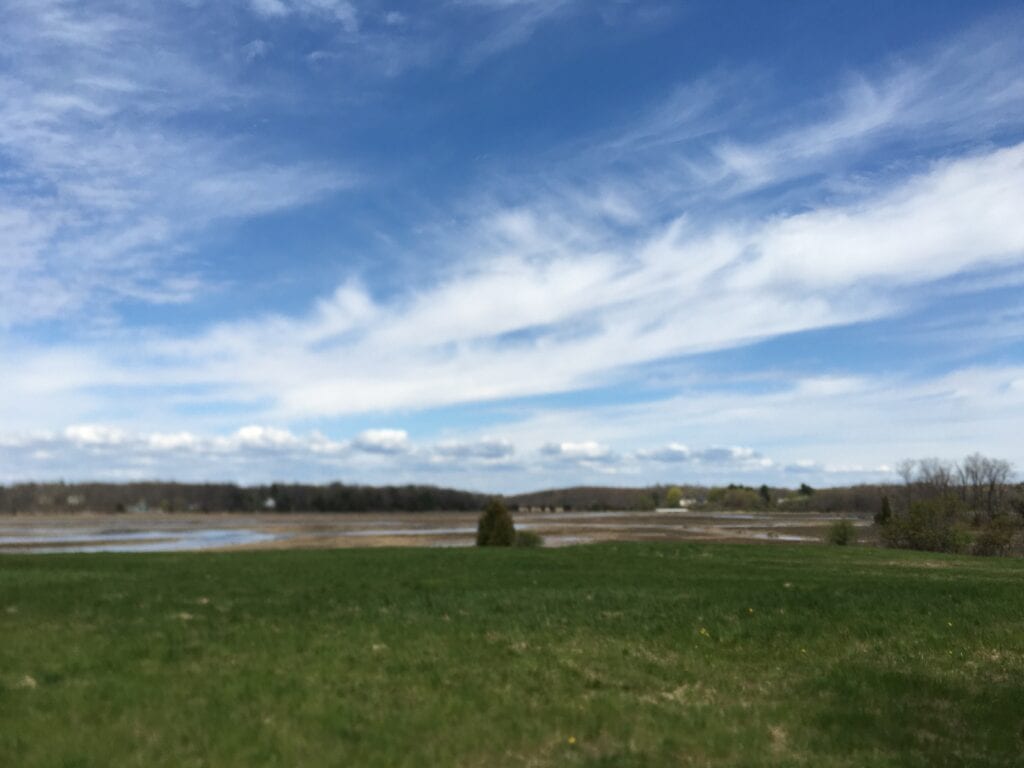An ecotone is an area of transition area between two biomes. It is where two or more communities meet and integrate.It may be narrow or wide, and it may be local (the zone between a field and forest) or regional (the transition between forest, grassland and water(ecosystems). An ecotone may appear on the ground as a gradual blending of the two communities across a broad area, or it may manifest itself as a sharp boundary line. The word ecotone was coined from a combination of eco(logy) plus -tone, from the Greek tonos or tension – in other words, a place where ecologies are in tension… a place that is heterogeneous in nature and offers opportunities for a blended sustainability- or not.
One of my favorite ongoing observations while a Teacher in Residence at the University of New Hampshire was supervising a student teacher in a high school environmental science class for a year while studying bug life diversities and habitats on the many ecotones of an expansive school grounds consisting of streams of water, old growth forests, and natural overgrown fields. Encroaching the natural were athletic playing fields treated with an assortment of chemicals for maintenance; parking areas treated with winter salt; and a cut-through with high tension wires running along the edge of the property. While they took samples of bug life in the different areas over time, the real interesting findings were which species survived and ultimately lived in the ecotone’s blended environments; where field met stream, forest met athletic fields, etc.
The experience resonates for me today and is a metaphor for the current state of education. Teaching and learning is caught to an extent in the old growth of 20th Century practices of education which still predominates school cultures. New 21st Century educational ecosystems where technology provides possibilities for flexibility of time, of pace and of place is changing the landscape of possibilities for of what schools, teaching and learning will look like going forward. In this context, the interesting questions for me are: Who and what will survive as we continue moving forward? What will the blending of the past and future look like as virtual options and personalization become more the norm?…and what will educators need to do or how will they need to change in order to survive in an ecotone of a fading 20th century model that will be increasingly dominated by 21st century possibilities? The inevitable change is where the notion of the disintermediation of public schools enters the discussion; and the impact the 2020-21 pandemic has accentuated the tensions of the virtual and blended teaching and learning possibilities emerging today with 20th Century dogmas.
At the turn of the century, Paul Houston, the former Executive Director of the American Association of School Administrators wrote, “Our public schools are being disintermediated, which he described as a new technology replacing or overriding an older institution.” One of the earliest examples of disintermediation that he cited was Johannes Gutenberg’s invention of the printing press in the early 1430’s. He noted that the printing press allowed the Bible to be mass produced and people no longer needed to go to church to receive religious doctrine. Religious institutions became more decentralized and greater numbers of people rejected formalized religion altogether. This change didn’t occur overnight and it takes historical perspective to understand the long-term impact the printing press has had on society. But, this example brings us to the current challenge schools are experiencing with current technology that is so quickly impacting schools.
The technology impact on schools resulting in their 20th century disintermediation can be seen on a number of fronts ranging from specialized, free options like Khan Academy; to virtual schools; to personalized learning environments that occur outside the walls of a classroom. As with the printing press and churches, students don’t need to come to school for the information to the extent they once did, so we must think and act around the question of, “why will students need to come to school?“. Ignoring the question will lead to the disintermediation of public schools as we’ve known them…examples of this can be seen across the country as public charter schools, private corporate supported schools, and home schooling become more widely accessed. The pandemic and a yearlong hybrid and remote models used by schools this past year is accelerating the process to a degree with more students and families living outside the ecotone of a traditional school. The year of the pandemic plays into the Disruptive Innovation Theory described in Clayton Christensen’s et al’s book, Disrupting Class, where one indicator from the 2008 book predicted that by 2024, 50 to 80% of high school seats will be delivered online! Again, the pandemic has simply advanced the impact technology was already having on schools.
Some states are ahead of the curve in providing a safe, constructive spaces for both the face-to-face and virtual teaching and learning ecotones. Both New Hampshire’s public online school, VLACS(www.vlacs.org); and Florida (flvs.net) have experienced exponential growth that is primarily student driven. Their models though have supported transitioning environments and professional development opportunities in brick and mortar schools as well. VLACS has grown exponentially, and consistent with Disruptive Innovation Theory the majority of student enrollments are an example of the virtual innovation and possibilities making their way back into traditional school settings….the forming of the metaphorical ecotone blending schools most adults have known with the schools and technology they will need to know and come to understand.
Hopefully, this blog will support the blending technology, literacy and collaboration across the broad area of virtual and brick & mortar learning environments that must coexist to varying degrees to support the 21st Century teacher and learner. Why will students come to school in 2024 and beyond; what will “school” look like? They are important questions to consider and I found the series of Shift Happens videos interesting to initiate conversations around these questions. One of my favorite versions is:
